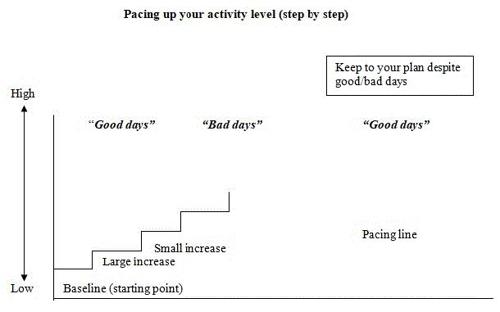A common story from children with activity related pain is that they push themselves until they feel the pain tells them to stop. Then they rest, possibly take pain relief, and wait for the pain to ease.
After a period of rest the pain may ease a little and then they will get up and try again - only to find the same thing happening all over again. After repeating this pattern over and over, they may also start to get frustrated at not being able to do many of the things they used to do quite easily. Eventually this can lead to feeling that the pain is controlling their life.
The diagram below shows a common picture many people with chronic pain report.

Each episode of increased pain makes it more tempting to avoid taking part in activities that result in more pain. Over time, reduced activity (excessive rest) will cause the body to lose condition, with joints becoming stiffer and muscles becoming weaker.
As your body loses condition it will gradually become less able to cope with a higher level of activity. Over time, less and less activity will be needed to overdo things. Rest or low activity period tends to become longer and total daily activity tends to become less and less.
The effects of inactivity on our bodies
In a surprisingly short period of time too much rest can have marked effects on our body which can include, loss of muscle strength, joint stiffness, reduced bone strength, increased tiredness and fatigue.
Other drawbacks to the cycle can include:
• fare-ups in pain severity (which can last for hours to days).
• the pain decides how much you do, not you (you don't feel in control of your daily life).
• life becomes difficult to plan ahead because the pain might play up.
• difficulty in joining in activities in school and homes.
• you can start to feel that you are never getting anywhere (and end up with feelings of frustration, failure and even sad).
Why children remain in this activity/pain/rest cycle
Whilst most children say they can see this pattern of activity is not getting them anywhere they find it hard to get out of. After all, they can see how important it is to keep active and to lead as normal life as possible - it's just that each time they try, the pain stops them.
Some children say they can't stop because they have no choice (for example to keep up at school or home). Others say such things as "it feels better to finish things" or "activity is often enjoyable, and it helps to distract me from the pain".


